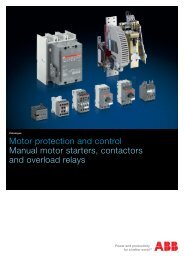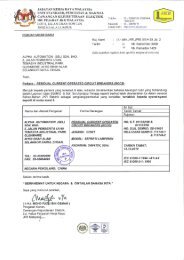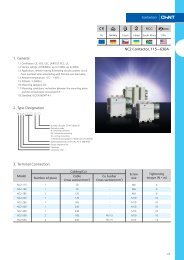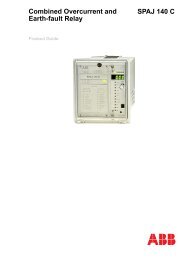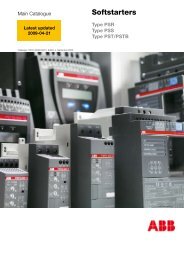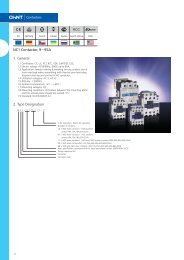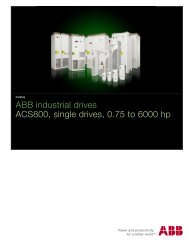Emax Low voltage air circuit-breakers - ABB Download Center
Emax Low voltage air circuit-breakers - ABB Download Center
Emax Low voltage air circuit-breakers - ABB Download Center
You also want an ePaper? Increase the reach of your titles
YUMPU automatically turns print PDFs into web optimized ePapers that Google loves.
Directional protectionZone selectivity D (Directional Zone Selectivity)Thanks to this function, it is also possible to obtain selectivity in meshed and ring networks.By means of zone selectivity with function D “Zone selectivity D”, which can only be set to [On]when zone selectivity “S” and “G” are set to [Off] and there is an auxiliary power supply, it ispossible to coordinate the behaviour of the various PR123 devices, by cabling the trip unitbuses in a suitable way.In fact, each trip unit has 4 signals available:– two input signals (one in a concordant and one in a discordant direction) by means of whichthe trip unit receives the “block” signal from other trip units– two output signals (one in a concordant and one in a discordant direction) by means of whichthe trip unit sends a “block” signal to other trip units.The <strong>circuit</strong>-<strong>breakers</strong> which do not receive a “block” signal (coordinated in the direction of thecurrent) will send the opening command within a time equal to “t 7sel”.The <strong>circuit</strong>-<strong>breakers</strong> which receive the “block” signal will open within the backward or forwardtime according to the direction of the current.If function I is activated and the short-<strong>circuit</strong> current exceeds the set value (I 3), the <strong>circuit</strong>-breakerwill open instantaneously and independently of the directions and of the signals received.For safety reasons, the maximum duration of the “block” signal is 200ms.If, after this time and for any reason, the <strong>circuit</strong>-<strong>breakers</strong> due to trip have not yet opened, the“block” signal falls on the other <strong>circuit</strong>-<strong>breakers</strong> which will command immediate opening. Thisoperation therefore occurs after a maximum time of 200ms.A shielded twisted p<strong>air</strong> cable (not supplied; ask <strong>ABB</strong> for information) can be used to carry outthe cabling. The shield should only be earthed on the trip unit of the <strong>circuit</strong>-breaker on thesupply side.• The maximum length of the cabling for zone direction selectivity, between two units, is 300metres.• A maximum number of 20 <strong>circuit</strong>-<strong>breakers</strong> can be connected to the outputs (OUT Bw or OUTFw) of a trip unit.6Direction (OUT-IN)Bw ➞ BwBw ➞ FwFw ➞ FwReference DirectionArrowThe figure below shows the connections necessary to activate the “blocks” between the varioustrip units. In particular:1) in the case of a fault in A, <strong>circuit</strong>-breaker QF1 is passed through by a current from busbar B1;this current flows in a direction discordant with the one set. The OUT Bw bus of QF1 “blocks”the IN Fw bus of <strong>circuit</strong>-breaker QF2 and the IN Bw bus of <strong>circuit</strong>-breaker QF3: in fact, thecurrent flows through QF2 inthe same direction as the setting,whereas QF3 is passedG1G2through by a current discordantwith the setting (the ac-ABtive “block” signals are indicatedby wider arrows).QF1 +PR123I>INFw BwOUTFw BwQF2 +PR123I>INFw BwOUTFw BwCB1QF3 +PR123I>INFw BwOUTFw BwDM1SDC200191F00016/16<strong>ABB</strong> SACE




